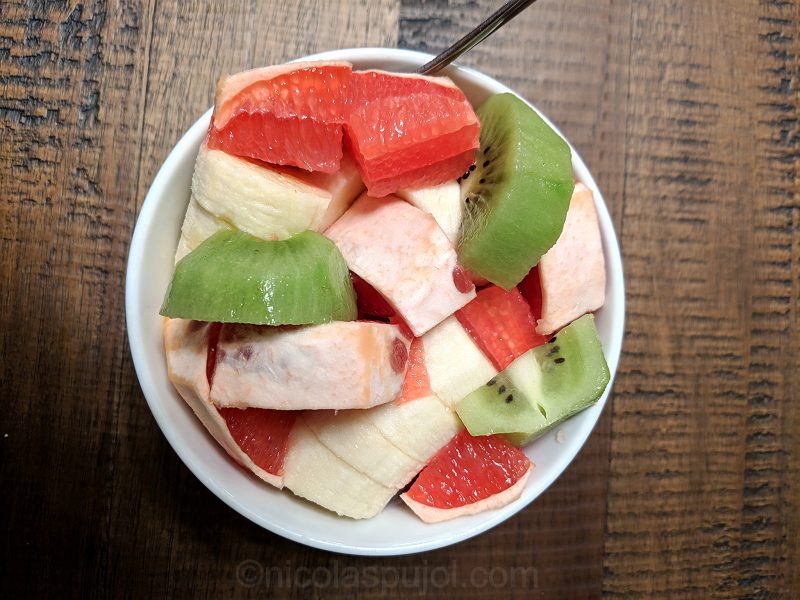Humans have done fasting for centuries, as part of intended programs like religious traditions, or in more stressed situations like famines and periods of starvation. As a result, our DNA represents the result of this adaptation, and the subsequent survival of the human species. Compare these times to modern society: constant feeding, processed foods, and much more protein and sugar than we ever had available before. In a series of scientific experiments documented in the Longevity Diet, Dr Valter Longo has shown the potential benefits of fasting, helping to lose weight, feel better, and perhaps more importantly, remove senescent cells to rejuvenate the body.
FMD summary plan
The concept of fasting-mimicking diet is to trick the body into thinking it is experiencing a full fast, like a water fast, except you can eat certain foods during the period. This makes the exercise much easier psychologically and physiologically. According to Dr Longo, here are the key elements of a fast mimicking diet*:
- During the week prior to the FMD, eat 0.36 grams of protein per kg of body weight per day, preferably from plant-based sources and fish. Take a multi vitamin and omega-3 supplement twice a week.
- Day 1: 11o0 calories total, comprised of 500 calories from complex carbs (broccoli, tomato, beets, beans, etc), 500 calories from healthy fats (nuts, olive oil, avocado), and 25 grams of plant-based proteins, preferably from nuts.
- Day 2-5: 800 calories total, comprised of 400 calories from complex carbs and 400 from healthy fats.
- Longo recommends 1 multivitamin and mineral supplement, plus an Omega-3/Omega-6 supplement every 3 days to every day depending on your needs. You can also take up to 4 plain teas (no sugar) each day and drink as much water as you need.
- Day 6 is called the transition day. Consume complex carbs without the calorie restriction (don’t binge either), and still keep the animal products (meat, dairy, eggs) to a minimum.
FMD resources on this site
A daily log of my experience testing a FMD regimen
Philosophical discussion: can dieting and fasting be an eating disorder?
FMD recipes
Longo recommends that for the strictest adherence to the target nutrition, you consume Prolon pre-made meals. This takes the approximation out of the equation, because when cooking your own meals you are going to be a little below or a little above the exact quantity of 1100, or 800 calories, and you may not get all the nutrients exactly as targeted.
On the other hand, cooking your own recipes has the advantage of using fresh produce, which supports another concept which Longo advocates for: eating how our ancestors have been eating for centuries. If you see that some calorie count in the recipes is too high for a meal, divide the quantities in two, or the number that makes sense for you to reach your total calorie goal for the day.
If you decide to do it yourself, I recommend you use a kitchen scale to weigh all ingredients so that you can accurately calculate calorie consumption for your meal plan.

A note about coffee during the fasting-mimicking diet
Dr Longo recommends that you avoid coffee during the fasting period, if possible. My personal experience is that I feel better keeping coffees, of course drinking them black without any sugar or cream, not even soy milk. It has to be zero added calorie to the black coffee, tea, whichever drink you consume. Lemon juice is another option, also unsweetened.
Fast mimicking diet (FMD) breakfasts
The following recipes are plant-based, and in the spirit of the FMD. For convenience you can find the calorie count on each of the links below. Once again, feel free to scale down the ingredient amounts to get the amount of energy you need for your meal. Finally, remember that using these FMD recipes is an exercise of precision: try to measure all the calories you are taking in, especially oils. Just one tablespoon of olive oil, as healthy as it may be, is 120 calories. It can add up very quickly and defeat the fasting process.
Strawberry, raspberry and banana fruit salad (142 cal.)
Mixed berry fruit salad with pine nuts (128 cal.)
Fruit salad with mango, passion fruit, pomegranate (206 cal.)
Lemon, kiwi, strawberry and banana smoothie (109 cal.)
Grapefruit (with skin), kiwi and banana fruit salad (212 cal.)
Hot grapefruit green tea (103 cal.)
Fast mimicking diet (FMD) lunches
Vegan oatmeal with avocado and tomatoes (579 cal.)
Seared black beans, broccoli and onion (592 cal.)
Sweet potato and kale salad (901 cal.); reduce quantities for FMD compatibility.
Steamed leek and carrot salad with avocado (333 cal.)
Fast mimicking diet (FMD) dinners
You can use lunch and dinner recipes interchangeably, however my observation speaking to centenarians and elders who are very fit is that they tend to make their dinners small or occasionally skip dinner altogether. For the FMD, Dr Longo recommends that total calories be divided between breakfast, lunch and dinner (no skipping), or as two meals and a snack. In this case, making the dinner the snack can make sense. It is also best to eat your dinner not too late, so you are awake during the digestive process, taking about 3 hours. So if you plan on going to bed at 10 pm, aim to finish your dinner by 7 pm.
Sauteed beets {beet fricassee} (174 cal.)
Sweet potato fricassee (393 cal.)
Baked or seared onion appetizer (83 cal.)
* Source: Longo, Valter. The Longevity Diet: Discover the New Science Behind Stem Cell Activation and Regeneration to Slow Aging, Fight Disease, and Optimize Weight (p. 114). Penguin Publishing Group. Kindle Edition.

Leave a Reply